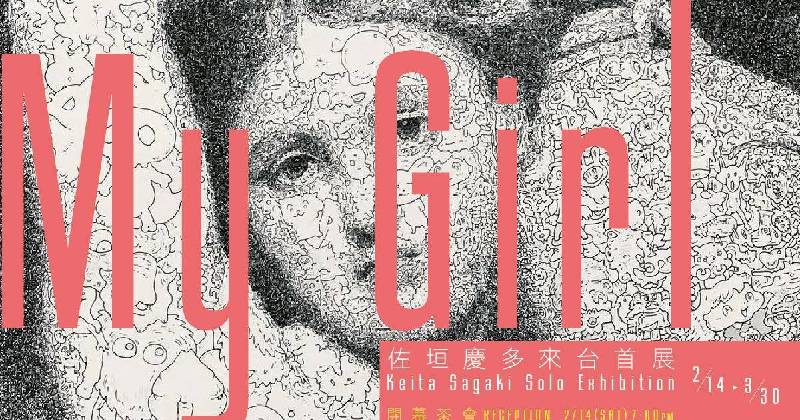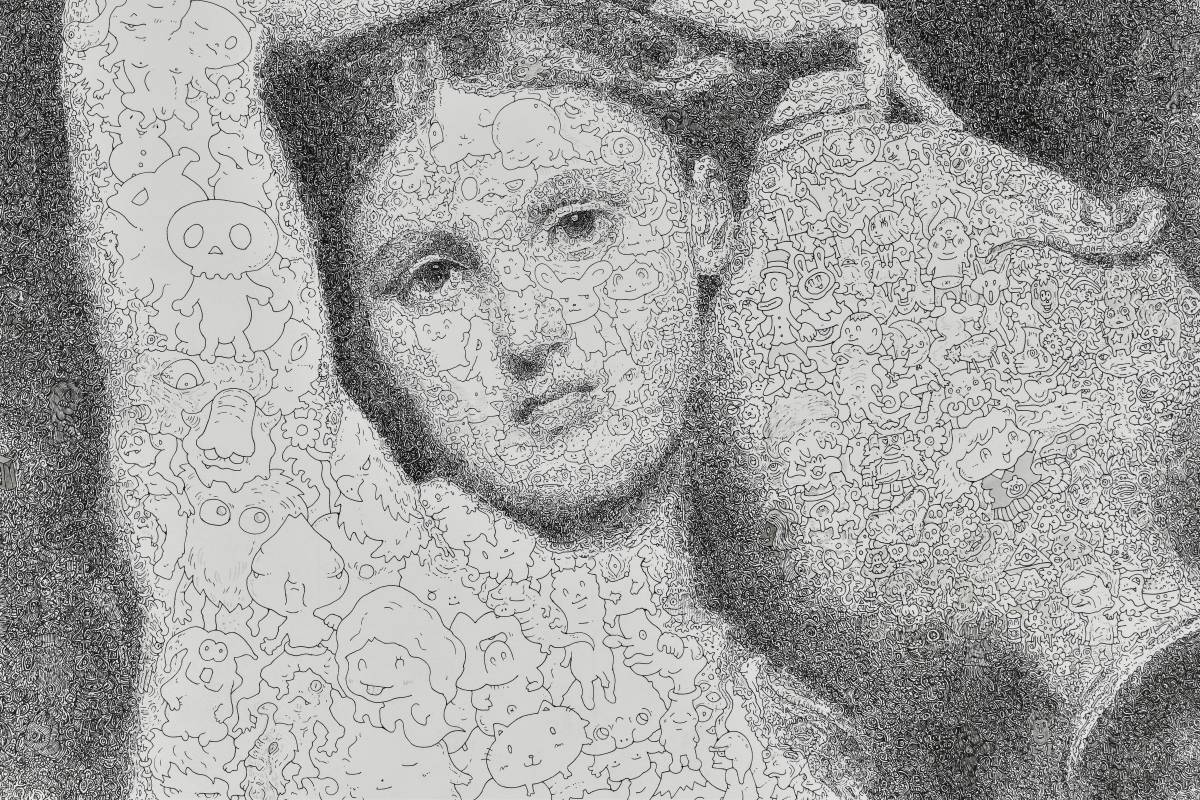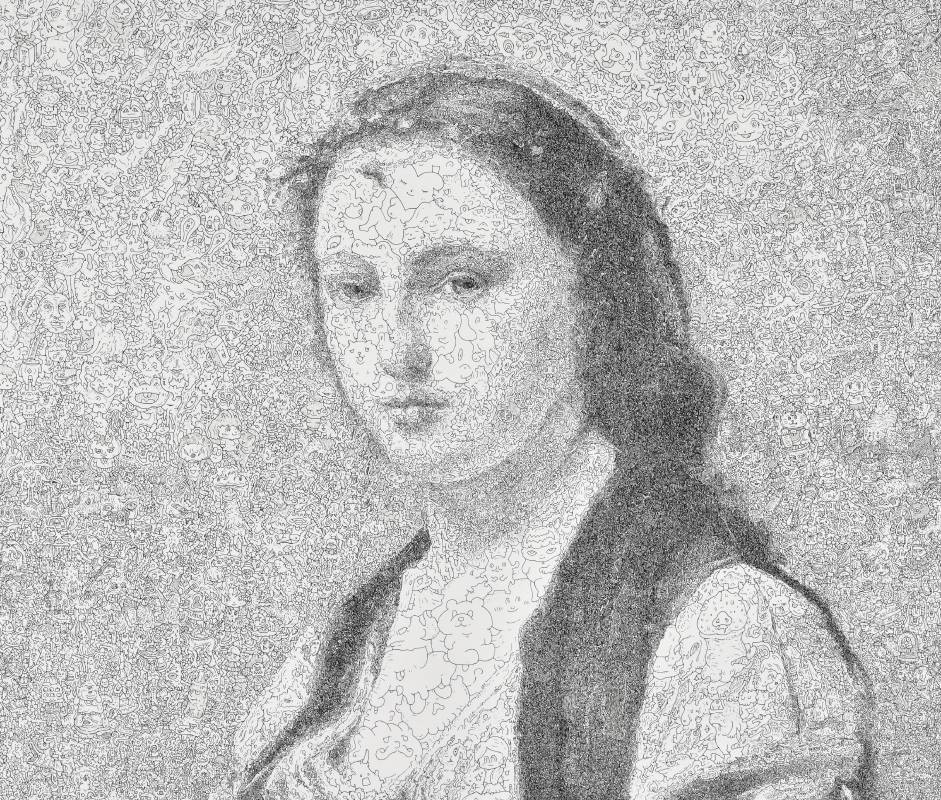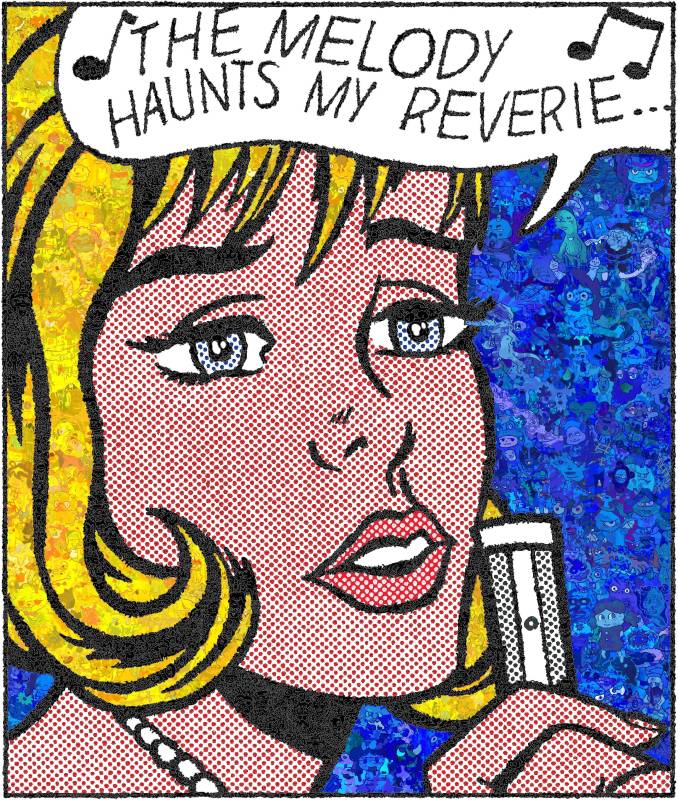多納藝術
【My Girl: 佐垣慶多來台首展】My Girl: Keita Sagaki Solo Exhibition

-
展期
日期:2019-02-14 ~ 2019-03-30
-
地點
台北市大安區基隆路二段112號7F
-
參展藝術家
佐垣慶多 Keita Sagaki
-
夢中的女孩 My Girl
CNN狂熱推薦!日本藝術家佐垣慶多來台首展
開幕酒會登記
佐垣慶多的《我的女孩》系列
文/陳貺怡 巴黎第十大學藝術史博士、國立臺灣藝術大學美術系所專任教授
任誰見到日本藝術家佐垣慶多(Sagaki Keita)的作品都會感到訝異:波提且利(Botticelli)的〈維納斯的誕生〉、達文西的〈喬孔達〉(La Joconde)與〈最後晚餐〉,或是葛飾北齋的〈神奈川衝浪裡〉,乍看是以鉛筆與墨水在紙上對經典名作進行維妙維肖的臨摹,但細看卻驚奇的發現這些「素描」的灰階、調子、立體感與空間感均是由數以千計疏密不均、大小不一的漫畫角色與圖像拼集組構而成。從形式來看,這種由無數密密麻麻的細節或是元素構成整體的方法,繼承自秀拉(Seurat) 的點描、塞尚(Cézanne)的建構、米羅(Miro)與波洛克(Pollock)的滿佈式構圖、李欽登斯坦(Lichtenstein)的網點,或是克羅斯那些遠看與近看差距甚大的巨大人像,基本上都顛覆了圖與地的關係、造成錯視,或顛覆了觀眾觀看的方法。
從主題來看,佐垣慶多則是個不折不扣的挪用主義者(appropriationniste),雖然1984年出生的他與活躍於1990年代的前驅如斯圖爾特文(Elaine Sturtevant)或Sherrie Levine等非屬同一世代,但對於藝術史圖像的挪用卻是一樣熱衷。當年在杜象(Duchamp)或蒙德里安(Mondrian)的名作下簽名的Sherrie Levine即曾宣稱:「世界已滿到令人窒息的地步(…)畫家的後繼者是剽竊者(…)有的只是可以在其中盡情擷取的龐大百科全書。」作為「龐大的百科全書」,藝術史提供了當代藝術家一個取之不盡用之不竭的資料庫。圖像的挪用早已其來有自,也曾經挪用過〈喬孔達〉的杜象可能是始作俑者,甚至我們可以追溯到馬奈(Manet),並且他們挪用的對象往往並非原作,而是複製的複製、在現的再現,用以點明布希亞(Baudrillard)的擬仿(Simulacre)的概念。但是相較於1990年代的挪用主義者,佐垣慶多卻不是單純的剽竊者,他在這些大師的圖像中加入了一些新的元素,只能說他「重製」(remake)了這些畫作。
然而,佐垣慶多的偶像並不是他所臨摹的這些古典大師,在漫畫文化高度發展並具有獨特影響力的國度裡成長,使他從小渴望成為漫畫家,手塚治蟲(Osamu Tezuka)、藤子不二雄(Fujiko Fujio)以及吉卜力工作室(Studio Ghibli)才是他崇拜的對象,搖滾樂和塗鴉則是他的喜好。但是當他最終成為一位藝術家,他思考的是如何在創作中同時展現漫畫家與藝術家這兩種身分,並且巧妙的揉合一些隨之而來的對立:例如高與低、東與西、近與遠。從他的訪談中我們可以知道西方古典大師與日本漫畫的遇合,源自於他對東、西繪畫根本差異的思考:「西方繪畫與日本藝術包含著許多衝突的概念。西方繪畫提供了深度,而我的漫畫角色卻是平的。即便在許多日本古典繪畫中,透視也不常被使用。」然而正是如此殊異的空間處理方式,讓西方藝術家對日本藝術驚艷不已,蔚為日本主義(Japonisme)。西方藝術與日本文化的匯聚已有百年以上的歷史,佐垣慶多的作品可說是更新了這個議題。而浮世繪版畫以常民文化之姿進入美術的殿堂,正如佐垣慶多將漫畫腳色串聯成古典名作一般,模糊了高藝術與低藝術的界線。二者之間的區別,尚需遠看或近看的視角,方能清楚的分辨而出。
不過,佐垣慶多的作品並不僅只如此而已,他也深受波希(Hieronymus Bosch)的影響;此外他的畫作令人立即聯想到朱塞佩·阿爾欽博托(Giuseppe Arcimboldo)那些以花卉、蔬果、海鮮、書籍堆成的肖像畫。這兩位超現實主義的先驅,作品中無不充滿了怪誕與奇趣,激發了想像力,召喚了潛意識。如此的比較並非空穴來風,事實上佐垣慶多不只一次表示他的創作方式受到曼陀羅(Mandalas)的啟發,不僅因為這種宗教繪畫是由無數的細節構成,更重要的是其創作的目的是為了再現「無意識的自我」(unconscious self)。佐垣慶多選定要模仿的名畫之後,即以不繪製草圖、無預先構想的類「自動性技法」(automatisme)創作,以自由聯想的方式填滿整個畫面。在名畫的典雅輪廓與細膩調子之理性框架下,任憑想像力奔騰與流瀉,從中竄出許多可愛、詼諧、奇趣的角色,但也有令人不安的異形與怪物,甚至包括裸女、陽具等大膽的原欲暗示,再次突顯其作品矛盾的特質,以及深沉與複雜的一面。
佐垣慶多這次為多納藝術繪製了一批新作,命名為《我的女孩》(My Girl),題材的刻意選擇使如此的命題與西方藝術史中的女性形象難脫關係:從安格爾(Ingres)的〈大宮女〉(La Grande Odalisque)與〈泉〉中的理想女體,到林布蘭特(Rembrandt)作為男性覬覦對象的聖經人物拔示巴(Bathsheba),浴女一直是滿足男性凝視的絕佳題材。而維梅爾(Vermeer)的作品則展現了女性的日常生活:勞動、彈奏樂器或讀信。柯洛(Corot)筆下的神祕女子肖像再度召喚了〈喬孔達〉,馬奈筆下的女畫家莫利索(Morisot)則充滿了知性之美。但也不乏令人感到威脅的女性形象:例如魯本斯(Rubens)筆下的蛇髮女妖梅杜莎(Medusa)猙獰而可怕的頭顱,孟克(Munch)充滿情慾的扭動女體,或是米萊(Millais)畫中神經質的伴娘,畢卡索筆下痛哭的女人。最有趣的當屬李欽登斯坦的《旋律讓我夢寐以求》(The Melody Haunts My Reverie),這是佐垣慶多極少數的彩色作品,他留下了人物身體上的網點,與其餘部分的漫畫圖像搭配的天衣無縫,證明了他與普普藝術的關聯。
所有的作品都是以一貫方式創作的獨立作品,但又同時串連成《我的女孩》系列,傳達著多元複式的訊息。這說明了佐垣慶多創作的無窮豐富可能性,以及他面對藝術史的態度,正如畢卡索在生涯晚期不斷重畫藝術史經典名作時所言:「這不是『重返當時』(temps retrouvé),而是『重新發現當時』。」
✒️About Author 陳貺怡
陳貺怡畢業於國立臺灣師範大學美術學系,旅居法國十四年,獲得法國巴黎第十大學藝術史與考古學系學士、碩士、當代藝術史(十九、二十世紀)博士。返國後曾任國立歷史博物館研究人員,負責策展、圖錄編纂及對法交流事務;現任國立臺灣藝術大學美術學系及碩士班專任教授,前系主任、所長。曾多次策畫國際與國內展覽,並曾擔任國立歷史博物館與臺北市立美術館等多項國際展策展顧問、廣達文教基金會顧問,各美術館審議委員、國藝會藝評台及國內外多項美術比賽評審委員。其藝術史相關著作及藝評散見於各期刊與展覽專輯。
開幕酒會登記
#MyGrils #SAGAKI #Keita #DonnaArt #多納藝術
期間:2/14~3/30
時間:上午11點至下午7點 (周日公休)
茶會:2/14 (四) 下午7點
地址:多納藝術 台北市大安區基隆路2段112號7樓
導航:https://goo.gl/maps/HgsiP9pYD4D2
展出藝術家
* 佐垣慶多
Keita’s Manifesto to My Girl
text/ CHEN Kuang-Yi
PhD of Contemporary Art (19th -20th Century), Université Paris Nanterre
Professor & former Dean of Fine Arts at National Taiwan University of Art
English/ Eddie
Everyone would be surprised by the works of Keita SAGAKI. No matter it’s The Birth of Venus by Sandro Botticelli, La Joconde and The Last Supper by Leonardo da Vinci, or even The Great Wave off Kanagawa by Katsushika Hokusai, they seem to be another lifelike reproductions draw from classic masterpieces with pencil and ink, yet if we look closely we’ll find these gray tone, sculpted and spatial “sketches” are indeed a huge collage composed with thousands of improvised manga characters in different sizes and densities. Formatively, this style of composition with countless parts of elements are, in fact, derived from Seurat’s Pointillism, Cézanne’s construction, Miro and Pollock’s full-spreading composition, Roy Lichtenstein’s Benday dot style, or even Chuck Close’s giant portraits with different details at close and distant look. It basically overturns the idea of “figure-ground relationship,” making illusions that subvert the way viewers watch.
From the perspective of the theme, Keita is a completely appropriationniste (French, appropriationist). Born in 1984, even though he is not in the same era of the 90’s pioneer artists like Elaine Sturtevant or Sherrie Levine, Keita surely is as enthusiastic as they were in appropriating masterpiece from art history. “The world is filled to suffocating (...) Succeeding the painter, plagiarist no longer bears within him passions, humors, feelings, impressions, but rather this immense encyclopedia from which he draws.” proclaimed Sherrie Levine, who once signed her names under the masterpiece of Duchamp and Mondrian. Being such immense encyclopedia, art history certainly breastfeeds an inexhaustible milk of database for contemporary artists. Nevertheless, there are already numerous appropriationniste before Keita. If we may say, Duchamp could be the first appropriationniste by appropriates La Joconde. We can even trace back to Manet, all of their object of appropriation is often the duplication of another duplication, representation of another representation instead of the original piece. This also points out Jean Baudrillard’s concept of Simulacre (French, Simulacrum). However, compare to the appropriationniste of 90’s, Keita remakes these masterpieces with new elements instead of simply representation.
Nonetheless, growing up in Japan, country of highly developing and mostly influential Manga culture, Keita wanted to become a manga artist like Osamu Tezuka, Fujiko Fujio, and cartoonists in Studio Ghibli instead of appropriationniste of classic art. Rock music and graffiti are his favorite as well. Eventually becoming an artist, Keita constantly tries to figure out a way to become both Manga artist and artist in his creations. Further, he cleverly blends some contrast at hands : high and low, West and East, near and far (distance of viewing). From his interview, we can understand the conjunction of Western masterpiece and Japanese manga is originated from his reflections on the essential differences between Eastern and Western paintings : “Western paintings and Japanese art contain many conflicting concepts,” Keita Sagaki explained in an email interview for CNN style. “Western paintings offer depth, while my characters are flat. Even in many classical Japanese paintings, perspective is not applied quite as much.” This is why western artists are often amazed by the so-called Japonisme (French, Japonism) for the extraordinary style of spaces. The convergence of Western art and Janpanese culture has a history over 100 years. Nevertheless, Keita’s work can be said to have turned a new leaf for it. If Ukiyo-e enters the hall of art in the form of profiling ordinary people’s daily life, we could say Keita Sagaki blurs the boundary between high art and low art with his creations that composing manga characters into the masterpiece. The distinction of two (high & low art) can simply tell from the distance of viewing to Keita’s works.
However, Keita’s artwork ain’t just that. He’s also deeply influenced by Hieronymus Bosch ; besides, his pieces remind people much of the works of Giuseppe Arcimboldo, portraits with bouquets, fruits and vegetables, seafood, and piles of books. They are regarded as the pioneers of surrealist duo, whose works filled with grotesque and whimsical ideas, the inspiration of endless imagination, and the summons of subconsciousness. Such comparison isn’t just come out of thin air, in fact, he elaborates more than once that his way of creation was indeed inspired by the Mandala drawings. Not only is this religious painting made up of countless details, but more importantly, the purpose of such drawing is the reproduction of the “unconscious self.” Usually, after Keita selecting particular masterpiece, there would be no pre-sketch for the entire work, in other words, a skill similar to “automatisme” thus created freely all over the paper through pure imaginations. Under the rational outline of the famous paintings and the delicate tone, he let the imagination run wild and shed, from which many of cute, witty and interesting characters are henceforce drawn. On the other hands, there are also disturbing aliens and monsters, even some bold hints that symbolize the primitive desires of human beings such as naked women, male genitals, etc. Thus once again highlights the contradictory qualities of Keita’s work, as well as a deep and complex side of it.
Keita Sagaki presents a series of new works in Donna Art’s solo exhibition titled My Girl. The deliberate choice of subject relates to inseparable engagement of female images in the Western art history : from ideal female body of Jean A. D. Ingres’s La Grande Odalisque and La Source, to Rembrandt’s biblical figure Bathsheba, in which female bathing has always been an exquisite subject to satisfy male gazing. Vermeer’s works, on the other hand, constantly display women’s daily laboring, instrument playing, and even letter reading. Corot’s portrait of a mysterious madame once again conjours La Joconde ; female painter Morisot seems more of intellectual beauty in Manet’s touch. Nevertheless, there are a few female images that are threatening. Such as the grim and dreadful head of Medusa by Rubens; Munch's lustful and twisting female body, the paranoid bridesmaid of Millais’s painting, or even Picasso's weeping woman. The most interesting none other than Roy Lichtenstein’s The Melody Haunts My Reverie, which is Keita’s rare creation in colors with Benday dots on character and the seamlessness manga images on the rest of spaces in which he proves his association with Pop Art.
All of Keita’s works are not only independent creations of a consistent style, but in the meantime connected into the center idea of "My Girl" in which convey multiple complex messages. This shows the opulence and infinite possibilities from Keita Sagaki’s works as well as his attitude towards art history. Just as Picasso said in his later years while he endlessly repainted the classic works in art history: “This is not ‘revisiting the moment’, but the ‘rediscovery of it.” (ce n’est pas le temps “temps retrouvé, ” mais “le temps à découvrir.”)
About Author CHEN Kuang-Yi
CHEN Kuang-Yi graduated from Department of Fine Arts at National Taiwan Normal University. She has lived in France for 14 years, where she received Bachelor and Master Degree of Art History and Archaeology, and Doctorate Degree of Contemporary Art (in 19th -20th Century) at Université Paris Nanterre. CHEN had worked as a Research Fellow at National Museum of History and was in charge of curation, catalogue editing, and international affairs with France. She is the Professor and former Dean at both the College and the Graduate School of Fine Arts at National Taiwan University of Art. CHEN has curated many domestic and international exhibitions and served as the curatorial consultant at National Museum of History, Taipei Fine Arts Museum, and Quanta Culture and Education Foundation, as the judging panel of many art
#MyGrils #SAGAKI #Keita #DonnaArt
2/14~3/30
11 am - 7 pm (closed on Sun.)
Opening:2/14 (Thu.) 7 pm
Reception: 2/14 (Sat) 7:00 pm
Vanue: 7th Floor, 112 Keelung Road, Section 2, Taipei
Map: https://goo.gl/maps/HgsiP9pYD4D2
Feature Artist(s)
* Keita SAGAKI
推薦展覽
view all多納藝術
【四季狂想曲-佐垣慶多個展 (10.16-12.29.2024)】Seasons Madness - Keita Sagaki Solo Show (10.16-12.29.2024)
日期:2024-10-16 ~ 2024-12-29|台灣,台北市
多納藝術
【漫遊人生 (09.19 - 11.28.2024)】Life is a Play Ground (09.19 - 11.28.2024)
日期:2024-09-19 ~ 2024-11-28|台灣,新北市
多納藝術
【五象之境 - 風景繪畫的形與意 (09.16 - 11.16.2024)】Realm of Five Elements - The Form and Meaning of Landscape Painting (09.16 - 11.16.2024)
日期:2024-09-16 ~ 2024-11-16|台灣,台北市












